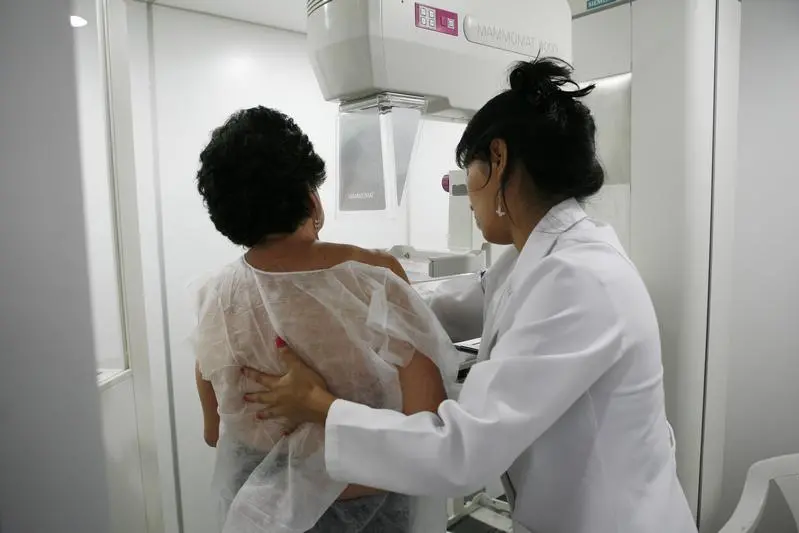PHOTO
We spoke to Dr. Shikha Saxena, Gynaecology and Obstetrics Consultant, at King’s College Hospital London Jumeirah Medical Centre to understand how and why women should make breast exams a part of their monthly routine,
"According to UAE health guidelines, all women over 20 should be breast aware while women aged 30 to 40 should get a clinical breast exam (by a doctor) done every three years. Women aged over 40 should do a clinical breast exam every year." Dr. Shikha said.
"While there are of course some high-risk cases, any woman can have breast cancer regardless of genetic background, lifestyle or history."
Being breast aware is all about gauging what is normal for you - as an individual woman.
"Women's breasts keep changing throughout the month and throughout their life. What is normal for me or you will not be normal for another person. The only way to know when something doesn't seem right is to understand what is normal for you personally and to then monitor your breasts regularly." Dr. Shikha said.
Before and during your shower is the best and most convenient time to do a self-examination.
Breast cancer is one of the most common cancers in the world but it also has one of the highest survival rates. Being aware of your body can help eliminate or manage breast cancer risk. You do not need to worry even if you find a lump or something abnormal. It could be anything from harmless fibroids to scar tissue. The most important thing is to know before it's too late.
Who should do a self-breast exam and when?
Every woman, under 18 or over 50 and everyone in between should do a regular self-check at least once a month."According to UAE health guidelines, all women over 20 should be breast aware while women aged 30 to 40 should get a clinical breast exam (by a doctor) done every three years. Women aged over 40 should do a clinical breast exam every year." Dr. Shikha said.
"While there are of course some high-risk cases, any woman can have breast cancer regardless of genetic background, lifestyle or history."
What does it mean to be 'breast aware'?
According to Dr. Shikha, 25 per cent of all women with cancer in the UAE, have breast cancer. "Given these figures, it is sad that there is still stigma over being aware of your own breasts and body", she added."Women's breasts keep changing throughout the month and throughout their life. What is normal for me or you will not be normal for another person. The only way to know when something doesn't seem right is to understand what is normal for you personally and to then monitor your breasts regularly." Dr. Shikha said.
When should you check?
Ideally it is best to check your breasts after your menstrual period as the hormonal changes during or right before menstruation can affect your results month to month. Breasts are also painful for many women during the time, which could make it harder to understand if something is wrong.Before and during your shower is the best and most convenient time to do a self-examination.
Which areas should you check?
The self-exam should include three areas of your body:- Breasts,
- Collarbone area and
- Armpits
What are you looking for?
In all these areas you are looking for:- Lumps, painful or otherwise
- Moving or fixed swelling in any of these areas
- Differences in skin texture like puckering or dimpling anywhere on the breast
- Any unnatural or painful discharge from the breast
- Drastic differences in shape or size of either breast (usually women tend to have slight differences in sizes, which makes understanding what's normal so important)
- Any rash or redness around the nipples
- Any pain that is not related to menstruation or other cyclical pains
Steps
- Stand straight with your hands loose by your side, look at your breasts and collarbone area. Look for any visible swelling in either area or skin texture differences on the breasts.
- Place your hands on your hips and bend forward. Watch the way your skin looks and the way your breasts move to check for anomalies.
- Place your palms on the back of your head and straighten up. Look at the armpits, and to the sides and under the breasts for any swelling, skin texture differences, rashes or shape variations.
- After this, lift only your left arm up. You can place the palm on your head or hold it straight up.
- Place your right hand on your left breast and use the pads of your fingers to start the exam from the centre of the breast.
- Move your fingers firmly, lightly pressing with the pads of the fingers, in concentric circles outward, feeling for lumps or swelling in the entire breast tissue. Also note any uncharacteristic pain.
- Do the same in the left armpit and the left collarbone area.
- Let your left arm down and repeat the entire process from Step 4 with your right arm up, using your left hand to check your right breast, armpit and collarbone area.
Why is it so important?
"Breast-feeding, healthy lifestyle choices and weight management have been proven to have some effect on mitigating the risk of this kind of cancer. However genetic factors, family history of cancer and age seem to be high-risk factors. However, researchers have not yet been able to find exact reasons or causes and until then, regular checks are vital for all women of all ages", said Dr. Shikha.Breast cancer is one of the most common cancers in the world but it also has one of the highest survival rates. Being aware of your body can help eliminate or manage breast cancer risk. You do not need to worry even if you find a lump or something abnormal. It could be anything from harmless fibroids to scar tissue. The most important thing is to know before it's too late.
© Al Nisr Publishing LLC 2017. All rights reserved. Provided by SyndiGate Media Inc. (Syndigate.info).












